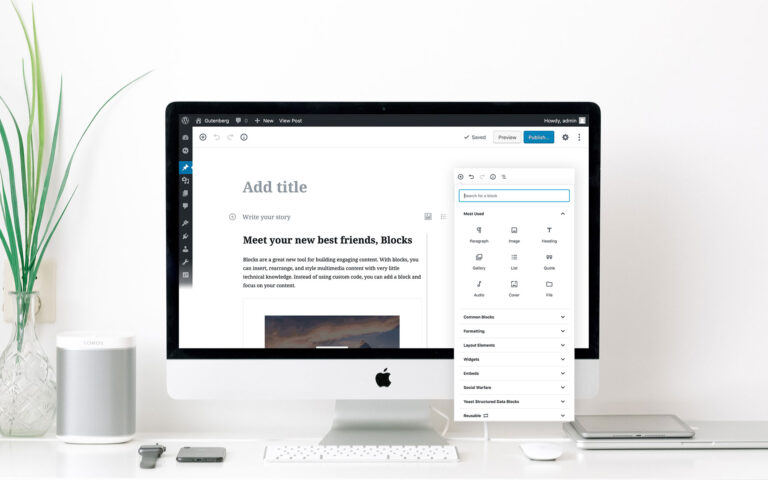What does that SEO term mean?
While we do our best to avoid jargon, there’s a number of terms related to SEO (Search Engine Optimization) that we can’t just get around. To bring some sanity to it, here are the deets on what everything means. We think.
“Incomprehensible jargon is the hallmark of a profession.” 🙄
Kingman Brewster, Jr.
What is a Broken link in SEO?
To a web crawler like Google’s bot, a broken link is a dead end. To visitors, it’s a dead-end and a signal you aren’t paying attention to the details. If that link was supposed to go to more information or an offer, that dead-end is likely costing you opportunities to convert visitors into leads and leads into customers.
What is a Redirect issue?
Redirects are created to take a visitor to another page when the original page has been moved or deleted. They are the railroad switch to another rail. If the rails loopback or go to the wrong place, it’s going to be a problem.
In flowww Site as a Service, redirects are created automatically via Redirection, a stellar plugin.
What does Search Engine Indexability mean?
While most parts of a website are indexed by search engines by default, it’s also common to block pages from being indexed. A landing page with a special limited-time offer is one instance where you may consider blocking search indexing. You may also consider blocking author-specific pages, PDFs, or other files because you do not always want them to be found by just anyone. However, you typically won’t want to block indexing for the majority of pages on your website unless you really don’t want people to find you. Blocked pages and URLs aren’t the only things on your website that may have indexing issues. Sometimes, an indexer will find that it is not allowed to access a page, or it cannot find a page, or the page simply won’t load properly.
Who cares if my Images have missing alt text?
While search engines can definitely read images, it’s the alt tag added to each image that helps tell them what the image contains and what its context is on the page. It’s prime real estate for topical phrasing and keywords, but be sure not to make it too long because screen readers used by those with vision impairments read alt tags aloud. Plus screen readers use these to speak the description to the sight-impaired.
Why would my Resource URL have repetition?
Why/Why/Why would this be an issue/issue/issue? Because it’s usually more machine-friendly than human-friendly. And, instances are most commonly found in places like nested file folders and deep pages. You’ll find the search engines prefer human-friendly. Truth!
Does it matter if my URL has a space?
A space in a URL is often shown as %20, and it may be read differently by different kinds of web server software. There is a significant chance that having one will result in a broken link because it’s actually a different address or filename than the original with a space in it.
Is time on page less than 10s* good or bad?
Whether this can be considered a problem depends largely on what you expect people to do on the webpage. Are they reading important or detailed information? How long do you feel someone should spend reading it? Is it a visual page that doesn’t actually require a lot of time? Generally, if visitors aren’t reading the page, it’s probably not helping you.
What does Canonicalized mean (with traffic*)
This might simply be good to know and is not indicative of a problem. This means that original — “canonical” — page received visitors, including human beings and bots. Is that what you want? You may have a duplicate or an incorrect setting. Check, and check again.
Error code 404 Not Found – with traffic*
This is a non-existent address with visitors. Ghostly. Some things to check are whether this was an old page that wasn’t redirected correctly, or perhaps a page that visitors are typing manually.
Why are people only visiting on the desktop from search*
Nobody on mobile is visiting the page. That might be intentional — the page may be somehow set up to require a desktop browser — but most visitors expect the same pages to be available on all devices. The page may be hard use on mobile, or inaccessible if it hasn’t been added to a mobile menu.
What does it mean if my bounce rate is greater than 80%?*
A high bounce rate can be an indicator that users didn’t find what they were looking for and left quickly. It can also mean that they found what they were looking for, but saw no reason to stick around. First, be sure that your website provides a great user experience and the content is easy to read and understand. Then, see if there’s anything you can add or adjust that will compel visitors to take the next step and explore your website.
Why are people only visiting on mobile from search*
Nobody on a desktop computer is visiting the page. Is that by design? Or is the page blocked? It is all by itself and nobody can find it? Have you linked to it? Look into these factors to start your investigation.
No desktop search traffic* Similar to FAQ #12.
No mobile search traffic* Similar to FAQ #12.
No tablet search traffic* Similar to FAQ #12.
Why don’t I have conversions?*
Did you want some? If not, it’s cool. Did you want a conversion? Check your forms to ensure they are working, and quickly. Also, check your marketing to ensure you’ve got the right call-to-action and content for your site visitors. Sometimes people just want to see a larger image or different colour, but they’re more likely looking for excellent content, so take a look at everything from the visitor’s perspective.
How can I compress text content?
Compressing your scripts, styles, and HTML reduces your page size and improves loading times because it takes the human bit out (spaces, italics, etc) and goes all computer. Enable GZIP compression for all text-based files.
Do I have to avoid character sets in meta?
This is pretty technical. Basically, different characters — letters, numbers, punctuation, and symbols — are made into computer code in different ways. There are a couple of ways to tell computers which code your webpage uses: “meta” tags are one way, but it’s inadvisable; the best way is to define it in your .htaccess file. If you’re not comfortable with changing your website’s .htaccess file, speak with your developer to have them adjust it.
Do I have to fill every empty src and href tag?
Instead of ignoring empty src and href attributes on images and links — as you may expect — some browsers will keep trying to find a way to fill in the blanks. That causes needless server requests, which slows your page down. Tip: if you have a link on a page that triggers a JavaScript action instead of being linked to another URL, use javascript:; as your href.
Why should I set cache headers?
Websites can tell visitors’ computers to keep a local copy of scripts, stylesheets, and images, so users don’t have to download them every time they visit a page on your website. But that can also mean that visitors can have older versions of those assets. Setting cache headers means that the website can tell users’ computers which assets to keep a cached copy of, and for how long.
Does it matter if I encounter (4xx) and (5xx) errors?
There are different kinds of error codes in the 4xx range, the most common being a “404 not found” error. See FAQ #1. Errors in the 5xx range are typically hosting or server errors. Talk to your hosting provider or your web developer and show them what you discover.
Are Redirects damaging?
Most common when redirects look back or go to a well-established page from a well-established page. How old is that redirect? Does it really need to be there? Google minimally deteriorates scores on redirects. So minimal, it’s not likely you need to put too much effort into them. Just don’t worry about setting them if they aren’t needed.
I have Small CSS responses. That’s a good thing, right?
Sometimes, this can be a very good thing because smaller CSS is generally better and more efficient CSS (see also FAQ #32). But if you have lots of little files, you should consider combining them into a single larger file, which reduces server requests and can be compressed more easily for a faster website.
What is a Page Resource?
This is a count of every resource used to build a particular webpage: the page itself, images, stylesheets, scripts, web fonts, and more. Every asset requires an additional server request and time to download, so a lower number here is better. It’s hard to set an absolute number for page requests, but it’s often best to keep it below about 40 requests.
What Site Speed should I be paying attention to? Should I care?
Faster loading times make visitors happier and are a search engine ranking signal. Google recommends that all pages should load in under 2 seconds and, ideally, under 1 second on mobile. Slow-loading websites will be unlikely to rank well and will almost never make the first page of search results.
What is Mobile Rendering?
Having a website that works as well on mobile as it does on desktop browsers is absolutely critical. Our audits look for common mistakes when building a website to make sure they work great on all devices, with avoidance of inline styling, small tap targets (fat thumbs are everywhere), and under 16pt (small) font sizes.
Why am I not seeing any Search Traffic?*
You should know which pages get traffic from search and which ones don’t. If a page isn’t getting traffic, look into whether it’s blocked from search indexing or isn’t linked from anywhere on your site.
What’s AMP?*
Accelerated Mobile Pages. They load content faster because they strip out formatting. Check to see how well your AMP is set up. AMP versions of pages need to have a valid canonical link and valid AMP format and should be listed in the sitemap and be indexable.
Neighbour or Neighbor. What’s the diff? How international settings affect search.
For many kinds of websites, search engines will tend to pick results that are in the same country and language as the searcher’s query. For example, it may be important for your website to declare whether it’s US English, UK English, Canadian English, Australian English, or another form of English. Similarly, it may be important to declare whether it’s in Spanish generally, Mexican Spanish, or Venezuelan Spanish.
Where’s my XML Sitemap and what’s in it?
Sitemaps should only contain the pages on your website that are indexable by search engines, and not contain duplicate pages or URLs that no longer point anywhere. Often found at yourdomain.com/sitemap.xml thought some sites place them elsewhere.
External links
Linking to external websites is great, but be aware that other websites may move at a different pace than you do. They may make mistakes when moving or removing a page that you’ve linked to. If you see an external link that has broken or changed, be sure to update it on your website.
Minify CSS URLs
Spaces, comments, and returns make your CSS easier to write and read, but they’re not important as far as a web browser is concerned. An automatic “minifier” can significantly reduce the size of your CSS file by removing anything unnecessary without affecting your website’s styling.
Minify JavaScript URLs
A good JavaScript minifier will remove comments and extra white space, and will also make your JavaScript expressions shorter and more concise. Complex function names will be made as short as possible, often to just one or two letters, but the functionality of the script won’t be affected.
Total CSS small
As with all things on your website, speed and lightness are key, and your stylesheets are no exception. They should be as small as possible, which means web browsers can build the page faster and there’s less chance of page content moving around as it loads.
Small total image size
Avoid having too many big images on any single page. Big images take a long time to load and, for mobile users on metered plans, can be expensive. Also, remember that not all website visitors will have a fast internet connection.
Total page size desktop
We call this the 2/2 rule: your pages should each load in under 2 seconds and be less than 2 MB.
Total page size mobile Check FAQ #25 above.
Content does not scale
Different screen sizes across different kinds of devices mean all content — including images and videos — must fluidly grow and shrink if you want all of your visitors to have a good experience.
Use legible font sizes
We’re all getting older. If I need to squint to read it, I’m gone. Google prefers a font size of 16px or larger for mobile.
(5xx) URLs in Sitemaps
Your sitemap should only have pages in it that are indexable and which are available. Errors in the 5xx range indicate pages that are misconfigured at the server level. It could be a problem with the .htaccess file or some improper code under the hood. It’s best to check with your developer because errors like these send a signal to search engines and visitors what your website isn’t well-maintained.






